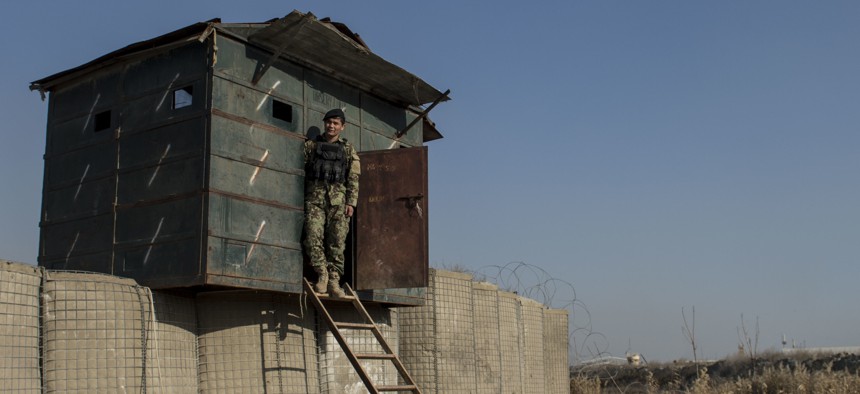
An Afghan airman stands at his security post near Forward Operating Base Oqab in Kabul, Afghanistan. Air Force Staff Sgt. Corey Hook
Afghanistan Growing More Dangerous for U.S. Rebuilders
Lack of security makes it nearly impossible to manage reconstruction projects.
In the latest in a grim series, the Special Inspector General for Afghanistan Reconstruction on Friday published a quarterly report highlighting the “fragile and worsening” condition of the economy and security climate in the war-torn country.
After a decade of reconstruction and a U.S. investment of $113 billion, “intractable insurgents, cutbacks in foreign military personnel, persistent emigration of people and capital, and a slowing global economy are shifting Afghanistan's economic prospects from troubling to bleak,” watchdog John Sopko wrote in the report, which covered the final months of 2015. “In this reporting period, Afghanistan proved even more dangerous than it was a year ago. The Taliban now controls more territory than at any time since 2001.”
Even worse for Defense and State Department program managers and auditors, “the lack of security has made it almost impossible for many U.S. and even some Afghan officials to get out to manage and inspect U.S.-funded reconstruction projects.”
The country's large budget deficits and trade imbalances “will require substantial donor aid for the foreseeable future,” Sopko wrote, citing a Pentagon estimate that the Afghan economy cannot grow quickly enough in the next five years to cover a significantly larger share Afghan defense force expenses. Costs for 2016 are projected at $5 billion for a force that has seen its troop strength fall by more than 9,000 since May 2015.
In a pointed and detailed essay, the IG wrote that “neither Afghanistan’s security outlook nor its economic prospects are doing anything to inspire confidence among the population.” A survey of Afghans nationwide by the Asia Foundation showed that “Afghans are particularly concerned about security, and the proportion who fear for their personal safety is at the highest point in the past decade.”
The Kabul Passport Office, the report adds, is issuing more than 2,000 passports a day, six times the pace of a year earlier. Many applicants are young educated Afghans fleeing to the European Union.
The United States still has $11.5 billion of appropriated funds in the pipeline for disbursement around Afghanistan, the report noted. But heavy spending so far has produced too little in results. The U.S. Agency for International Development, for example, has spent at least $2.3 billion since 2003 on stability programs in Afghanistan. Yet a third-party evaluation shows that villages receiving money still score low on stability measures, and “some villages reportedly under Taliban control that received USAID stability projects subsequently showed greater pro-Taliban support. USAID appears to be largely indifferent to the implications.”
Sopko credited SIGAR itself with saving more than $2 billion to date through identification of waste, fraud and abuse. The accomplishments this quarter “bring the cumulative total in criminal fines, restitutions, forfeitures, civil settlement recoveries and U.S. government cost savings from SIGAR’s ongoing investigations to over $946.2 million,” the report stated.
Since 2008, SIGAR has referred nearly 700 individuals and companies for suspension or debarment based on evidence developed as part of its investigations.
More grim news is likely on the horizon. The watchdog has launched an inquiry requested by Congress on the U.S. government's experience with allegations of sexual abuse of children committed by members of the Afghan security forces.







